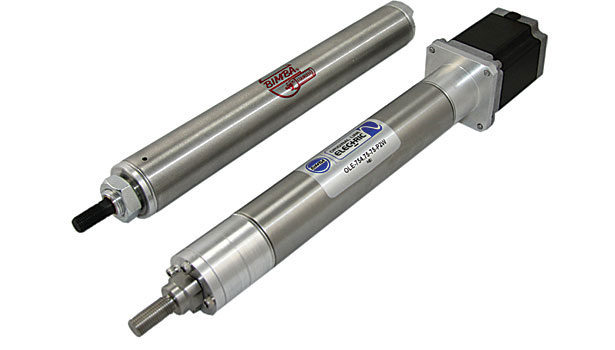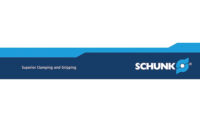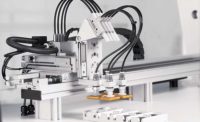Are you considering replacing a compressor and 200 pneumatic cylinders with electric actuators to save money on compressed air? Or, perhaps you’re thinking about building a new machine with pneumatics because 30 electric actuators cost a whopping $34,000.
Either way, you might be making the wrong decision and wasting tens of thousands of dollars annually. The choice of pneumatic or electric actuators involves an evaluation of performance, component costs, system costs and productivity gains. The two technologies are so different that one cannot be a drop-in replacement for the other. Each has inherent advantages and disadvantages.
Pneumatic Actuators
Pneumatic actuators provide high force and speed at a low unit cost in a small footprint. Force and speed are easily adjustable and are independent of each other. The typical pneumatic application employs oversized cylinders as a safety factor. This is common because pneumatic cylinders are inexpensive and stepping up to the next larger diameter is feasible and practical. Prices for non-repairable rod-type cylinders range from $15 to $250, depending on body diameter, stroke and options. Pneumatic cylinders provide more force and speed per unit size than any other technology, except hydraulics.
Pneumatics are most economical when the scale of deployment matches the capacity of the compressor. Small compressors are efficient and economical when used to power a small number of pneumatic devices. Large compressors are efficient and economical when powering a large number of pneumatic devices. Unused compressor capacity is costly. Time that a compressor sits idling at no load is also costly.
While pneumatic component costs are low, maintenance and operating costs can be high, especially if a serious effort has not been made to quantify and minimize those costs. Maintenance and operating costs include replacement cylinders, air line installation and maintenance, and electricity for the compressor. According to the Department of Energy, 24 percent of the annual cost of compressed air is due to maintenance, equipment and installation, while 76 percent is due directly to the cost of electricity for the compressor.
Typically, compressor efficiency is lower when the compressor is partially loaded. Furthermore, if during the work week, the compressors are left powered on at no load, a substantial amount of electricity is wasted. Waste is increased by inadequate maintenance (air leaks) and nonessential use of the compressor. Oversized compressors and cylinders, common today, are costly to operate.
Determination of the operating cost per pneumatic device deployed in a facility can be eye opening, especially if cost calculations have not been done for a while and the scale of operations has shrunk. If there are 500 pneumatic devices using a compressor, cost per device may average $100 per year, but if there are only 50 devices, then cost per device increases ten times to $1,000.
Electric Actuators
In contrast to pneumatics, electric actuators provide precise control and positioning, help adapt machines to flexible processes and have low operating cost. They are most economical when deployed in a moderate scale in processes where their performance advantages can be a benefit and when the electronics are separate from the actuator to segment and minimize replacement costs.
Electric actuators consist of a ball, acme or roller screw connected via a coupler to an electric motor. As the screw turns, it moves a nut, which is connected to the rod or carriage. The rod or carriage moves the load. Performance varies depending on materials used. Commonly used motors include steppers and servos. Brush DC motors and AC motors are sometimes used with limit switches when positioning accuracy is less critical.
Step motors are an economical choice for accurate positioning at lower speeds. However, steppers might lose synchronization with the controller when employed open-loop without an encoder or if they are undersized for an application. Servos, by definition, are closed-loop and provide superior performance at high speeds, albeit at a higher cost.
High-precision screws and anti-backlash mechanics can provide positioning accuracy to ten thousandths of an inch. Standard precisions with standard components range from a few hundredths to a few thousandths of an inch.
Speed and thrust are related in the physics of an electric actuator. Speed is surrendered for thrust and thrust for speed. This is an important distinction from pneumatic cylinders. For a given electric actuator, more thrust will be available at low speeds and less thrust at high speeds. This characteristic is more pronounced with step motors and less with servos. For this reason, accurate sizing in an application is critical. Increasing thrust at the same speed requires different designs using different components and materials. An increase in thrust and speed requires larger and more powerful components and materials, which increase costs.
Understanding and evaluating loading in the application under real conditions ensures specification of the right actuator while minimizing expense. Not understanding application loading leaves the engineer vulnerable to poor performance and high costs.
Besides a drive screw and motor, an electric actuator requires an amplifier to power the motor and a controller to control motion. The total cost for these components ranges from $800 to $3,000 and up.
Operating costs of electric actuators are largely from the power draw of the motor. The low-voltage circuitry in the amplifier and controller consume power to a far lesser degree.
While component costs of electric actuators are high, operating costs are low. High component costs often deter the use of electric actuators. However, potential savings in operating costs compared to pneumatics are not adequately considered or ignored.
For example, manual changeovers (adapting an assembly line to a different product) can be expensive in terms of both lost production and man-hours required to implement the change. Over the course of a year, if changeovers are required once a week and each changeover requires two people for four hours at $50 per hour, man-hour costs amount to $20,800 per year. If the line produces one assembly per minute and the value of each product is $10, lost production costs amount to $124,800. Thus, the total annual cost of changeovers amounts to $145,600.
Because they’re programmable, electric actuators can substantially reduce these changeover costs. The annual cost savings must be considered as part of the implementation decision.
When replacement cost, operating cost and process efficiency are considered, the annual costs of electric actuators are comparable to those of pneumatics. It helps when the scale of deployment is moderate and when motion system components can be replaced separately as they wear, rather than replacing an entire motion control system.
The Case for Electrics
To truly compare electric and pneumatic actuators, it’s useful to look at some examples.
Let’s say a plant uses a 100 hp compressor operating at full load 2,000 hours per year at 90 percent efficiency. It powers 20 pneumatic actuators, which average $50 apiece. When the compressor is not being used, it is idling at 25 percent power and 85 percent efficiency. The pneumatic actuators average a three-year life. Cost of electricity is $0.10 per kilowatt-hour.
Electric actuators are being considered as replacements. The electrics average $900 apiece plus another $1,200 for controls and power supplies. Each actuator draws 6 amps fully loaded at 48 VDC 30 percent of the time. The remaining time the actuators draw 3 amps. The power supply draws 6 amps at 120 VAC under full load, producing 9 amps at 48 VDC. The mechanical actuators have a three-year life span, while the electronics have a 10-year life span.
The life spans in this example are assumptions. The actual life spans of components will vary. Additionally, electrics will automate a line change that consumes two hours every week for two people who each earn $30 an hour. The line change stops production. For every hour of production, 100 assemblies can be produced at $1 each.
In this example, the cost of the pneumatic system is as follows:
- Annual cost of compressed air with the compressor at full load, $21,822.
- Annual cost of compressed air with the compressor at 25 percent, $19,351.
- Replacement costs of actuators, $333 per year.
- Total annual cost, $41,506.
If the old 100 hp compressor can be replaced with a smaller 50 hp unit, costs will drop. The new compressor will pay for itself in about a year and a half. If the compressor is turned off when not in use, costs would decrease even more. Savings could be as high as $25,000 per year. Note that the actual cost per pneumatic actuator drops from over $2,000 to about $300 apiece due to efficiencies in deployment.
In comparison, the cost of an electric system is as follows:
- Annual cost at full load, $576.
- Annual cost at idle, $672.
- Annual operating costs for 20 actuators, $1,248.
- Replacement cost for actuators, $6,00.
- Replacement cost of electronics, $2,400.
- Total annual cost, $9,648.
In addition, the electric system saved the following costs:
- Elimination of changeover labor, $6,240.
- Elimination of lost production due to changeover, $10,400.
In this instance, operating and maintenance costs clearly give the electric system a substantial advantage over the pneumatic one. Notice that total cost per year is $9,648, not including savings obtainable from increased adaptability of the machinery. Once we consider the gains from eliminating changeovers, implementation of the electric actuators actually reduces cost, rather than adding to it, by about $7,000 per year.
The Case for Pneumatics
A plant has a 200 hp compressor installed for pneumatics, operating at full load 2,000 hours per year at 93 percent efficiency. It will be used to power 150 pneumatic actuators, which average $50 apiece. When the compressor is not being used, it is turned off.
An alternative is to use electric actuators. The replacement actuators cost $1,200 apiece, which includes built-in drivers and controls, but not power supplies. Each actuator draws 6 amps fully loaded at 48 VDC, which is about 30 percent of the time. The remaining time the actuators operate at 3 amps. The power supply draws 6 amps at 120 VAC under full load, producing 9 amps at 48 VDC.
In this example, the cost of the pneumatic system is as follows:
- Annual cost of compressed air, $42,237.
- Replacement costs of actuators, $2,500 per year.
- Total annual cost, $44,737.
- Cost per pneumatic device per year, $298.
Even with a large 200 hp compressor, the cost per device is extremely low, benefiting from the large scale of deployment. If a 100 hp compressor could be used instead, costs can be cut further.
In comparison, the cost of an electric system is as follows:
- Annual cost at full load, $4,320.
- Annual cost at idle, $5,040.
- Annual operating cost for 200 actuators, $9,360.
- Replacement cost for actuators, $60,000.
- Total annual cost for electric system, $69,360.
Because of the large scale of deployment, the replacement cost of the actuators increases the annual system cost, making electric actuators impractical. The system would have to dramatically increase productivity to make it worthwhile pursuing.
In this instance, pneumatics proved to be the more economical alternative. Compressor utilization is more efficient because of the higher number of pneumatic actuators deployed. Electric actuator replacement costs drive up the electric system costs. Even with a modular electric actuator design, costs are substantially above pneumatic.
The initial cost of actuators is only one small consideration in a list of issues for implementing intelligent and cost-efficient automation. The high cost of electric components can be misleading, but so can high compressor operating costs. Neither tells the whole story.
Pneumatic operating costs can be controlled by sizing the compressor to fit the scale of pneumatic device deployment. Electric actuator costs can be minimized by accurate sizing, buying motion control components separately, and reserving them for applications in which they can improve process efficiency. Pneumatic actuators have advantages in cost, size, thrust and speed, but electrics have advantages in accuracy, flexibility and control, making machinery and processes more efficient. An upfront estimated assessment of an application can prevent oversights and produce considerable cost savings in the long run while also ensuring that equipment matches the tasks at hand.
Electric Actuator Operating Cost Calculations
Use the following equation to estimate the operating cost of an electric actuator:
Cost = Current x voltage x 0.001 x annual operating hours x electricity cost x duty cycle
Current is the current draw of the power supply or controller that provides power to the motor windings. Voltage is the AC line voltage. Duty cycle is the percentage of time the motor is drawing the specified current. Typically, a motor draws full current part of the time, a portion of the full current part of the time, and is idling another percent of the time under no load, when most of the current draw is due to the control electronics.
Let’s assume that we are using a DC power supply to provide power to the actuator. This power supply provides 48 VDC at a maximum of 12 amps. From the manufacturer’s data sheet, the power supply draws a maximum of 8 amps at 120 VAC. Our electric actuator cost calculation assumes that the motor of our actuator draws 6 amps of direct current fully loaded, and 1 amp of direct current at idle. Also, assume that half the current draw of the actuator translates linearly to half the current draw of the power supply.
The system runs 8 hours a day, five days a week, and electricity costs $0.10 per kilowatt-hour. The system idles half the time and draws a full load half the time.
Annual cost at full load = 120 x 4 x 0.001 x 8 x 5 x 52 x 0.1 x 0.5 = $49.92
Annual cost at idle = 120 x 0.67 x 0.001 x 8 x 5 x 52 x 0.1 x 0.5 = $8.36
For total operating costs, add the costs together, which amounts to about $58 annually per actuator.
We also have to estimate replacement costs:
Actuators = (cost per unit x quantity) ÷ life span
Electronics = (cost per unit x quantity) ÷ life span
If the actuator system costs a total of $1,200, of which the actuator itself costs $900 and has a three-year life span, total annual costs are about ($900 ÷ 3) + $58 or $358 for every actuator deployed. If the electronics are buried in the actuator and the whole unit must be replaced when the product fails, the total costs per year of ownership amount to $458 per year per actuator. Typically, electronics will have a longer life span and their contribution to maintenance expenses will be smaller.
Assessing Pneumatic Performance and Costs
With pneumatic actuators, force is proportional to the surface area of the piston. To calculate force:
F = (piston diameter)² x 0.785 x (air pressure)
For example, a 1.0625-inch-diameter cylinder at 100 psi produces 89 pounds of force.
Speed and force can be controlled independently. For more or less force, raise or lower the air pressure using a regulator. For reduced speed, use a flow control. These factors combine to make application sizing simple.
To make cost estimation simpler and faster, the following equation can be used to estimate of the annual cost of compressed air:
Cost = (horsepower x 0.982 x annual operating hours x electricity cost) ÷ efficiency
Annual operating hours represents the number of hours the compressor operates fully loaded per year. To calculate the cost of electricity, divide your total electricity bill by kilowatt hours consumed to get dollars per kilowatt hour. Efficiency is the efficiency of the compressor motor, as stated in the compressor specifications.
Assume the compressor is rated at 200 hp, and it operates fully loaded for 8 hours a day, five days a week. If the cost of electricity is $0.10 per kilowatt-hour, and if the compressor is 90 percent efficient fully loaded, the annual cost of compressed air can be calculated as:
Cost = (200 x 0.982 x 8 x 5 x 52 x 0.1) ÷ 0.9 = $45,390.24
This equation assumes that the compressor is either on at full load or off. In reality, compressors are often consuming electricity at no load while they are not being used, in the amount of 20 to 30 percent of the full load usage. In addition, compressor efficiency is lower when it is partially loaded (85 percent instead of 90 percent in our example).
If during the week the compressors are left on at no load, we might add the following to the total cost of compressed air:
No load cost = (200 x 0.982 x 16 x 5 x 52 x 0.1 x 0.25) ÷ 0.85 = $24,030.12
Total operating cost is found by adding the full load and no load costs, which amounts to over $69,000. If the actual compressor shaft horsepower is 5 percent greater, then both the loaded and no-load costs increase by 5 percent. If the compressor is shut off instead of left on continually, costs drop to $45,000.
The cost of replacement cylinders must also be considered:
Annual replacement costs of cylinders = (quantity x cost per cylinder) ÷ life span
Fully loaded compressor operating costs, no-load operating costs and total replacement cost of the cylinders should be added to determine total system cost. Divide this number by the number of cylinders deployed to find the average cost per cylinder.












